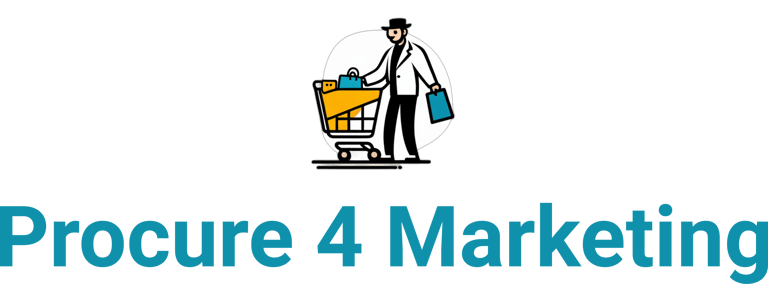Choosing a Supplier for a Marketing Campaign
A step-by-step case study on how FreshFoods Co. chose the perfect marketing agency, from writing the brief to evaluating proposals and making the final selection.
MARKETING PROCUREMENT
The Procure 4 Marketing Team
9/13/20233 min read


Quick Answer: How do you choose a marketing agency?
This case study of FreshFoods Co. illustrates a 5-step process for choosing the right marketing agency. The process involves: 1) Defining the Need by creating a detailed brief; 2) Creating a Longlist of potential agencies through research and referrals; 3) Issuing an RFP to create a shortlist of the top candidates; 4) Holding Pitch Meetings to evaluate the finalists on strategy and cultural fit; and 5) Making the Final Selection based on overall value.
The Challenge: An Organic Food Brand Needing to Grow Online
FreshFoods Co., a successful company specializing in delivering organic produce, wanted to expand its online presence and reach more health-conscious consumers. However, their small internal team lacked the resources and expertise to execute a large-scale digital marketing campaign. They needed to find the perfect external agency partner.
The Solution: A 5-Step Agency Selection Process
Here is the step-by-step process FreshFoods Co. followed to find, evaluate, and select their ideal marketing agency.
Step 1: They Defined Their Needs (The Brief)
Before starting the search, the FreshFoods team created a detailed internal brief that clearly outlined their goals and requirements.
Objective: Increase online sales by 30% within 12 months.
Services Needed: Content creation (recipes, blog posts), social media management, SEO, and email marketing.
Key Requirement: The agency must have proven experience in the food and wellness industry.
Budget: A clearly defined annual budget.
Step 2: They Created a "Longlist" of Candidates
With a clear brief in hand, the team conducted research to identify a broad list of potential agencies.
Methods Used:
They asked for recommendations from other businesses in the food industry.
They utilized online platforms like LinkedIn to search for agencies with relevant case studies.
They attended industry networking events to meet potential partners.
Result: A "longlist" of 10 promising agencies was created.
Step 3: They Issued an RFP to Create a "Shortlist"
To formally compare the candidates, FreshFoods sent a Request for Proposal (RFP) to the 10 agencies on their longlist. The RFP included their brief and asked the agencies to submit a detailed proposal.
Key Evaluation Criteria for Proposals:
Proposed Strategy: Was the creative and strategic approach innovative and on-brand?
Industry Experience: Did they demonstrate a deep understanding of the food industry?
Past Performance: Did their case studies show measurable results for other clients?
Price: Did the proposed cost offer good value and fit within the budget?
Result: After scoring the proposals, FreshFoods created a "shortlist" of the top 3 agencies.
Step 4: They Held Pitch Meetings & Checked References
The three shortlisted agencies were invited for in-depth presentations. This was a chance to move beyond the paper proposal and evaluate the human element.
Pitch Meeting Goal: To meet the actual team who would work on the account and to gauge their working style, enthusiasm, and cultural fit.
Due Diligence: After the pitches, the FreshFoods team called references for each of the final agencies to get firsthand accounts of their performance and reliability.
Step 5: They Made the Final Selection
After the final pitches and reference checks, the team made their decision.
The Winner: They chose "MarketFresh," an agency specializing in food industry marketing.
Why They Won: MarketFresh demonstrated the deepest understanding of FreshFoods' brand values, presented the most creative strategic approach, had glowing references, and shared a genuine passion for the organic food market. They offered the best overall value, not just the lowest price.
The Result & Key Takeaways
By following a rigorous and strategic process, FreshFoods Co. found a partner that was a perfect fit. The "MarketFresh" agency went on to launch a highly successful campaign that exceeded the initial goals.
This case study provides a clear roadmap for any business. The key takeaways are:
Always start with a clear brief. You can't find the right partner if you don't know what you need.
Cast a wide net during your initial research to ensure you find the best talent.
Use a structured evaluation process to compare candidates objectively.
Prioritize overall value and cultural fit, not just the lowest price.
Frequently Asked Questions (FAQ)
Q1: How long does a typical agency selection process take?
A thorough process like the one described can take anywhere from 6 to 12 weeks, from writing the initial brief to signing the final contract. Rushing the process is a common mistake that can lead to a poor partnership.
Q2: What is an RFP (Request for Proposal)?
An RFP is a formal document used to request detailed proposals from potential vendors for a specific project. It describes the company's needs and asks vendors to explain how their solution, team, and pricing would be the best fit.
Q3: What's the most important factor when choosing an agency?
While technical skills are essential, many businesses find that cultural fit and a shared understanding of the brand's vision are the most important factors for a successful long-term partnership. A skilled agency that doesn't "get" your brand will struggle to deliver effective work.
